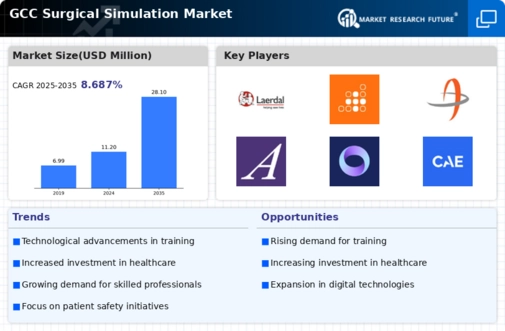The GCC Surgical Simulation Market is characterized by a rapidly evolving landscape where innovative technologies, products, and services are reshaping the way surgical training and education are conducted. This region has seen significant investment in healthcare infrastructure, driven by an increasing focus on improving the quality of surgical procedures and enhancing patient outcomes. The competitive insights within this market reveal a mix of established players and emerging startups, all vying to capture a share of a growing demand for simulation-based training solutions.
Factors such as advancements in virtual reality, augmented reality, and high-fidelity simulators are playing a crucial role in this transformation. Additionally, collaboration between healthcare institutions, educational bodies, and simulation companies is fostering an environment ripe for further growth and innovation.
Laerdal Medical holds a strong position in the GCC Surgical Simulation Market, noted for its commitment to enhancing medical training through realistic simulation experiences. The company has established itself as a leader in the development of high-fidelity medical simulators specifically tailored for various surgical disciplines. With a focus on producing educational tools that promote practical skills and decision-making in high-pressure environments, Laerdal Medical has earned a reputation for quality and reliability among healthcare professionals and training institutions in the Gulf region.
Its comprehensive product portfolio, which includes a variety of simulation scenarios and scenarios for both novices and seasoned practitioners, complements the healthcare initiatives being undertaken by GCC countries. The company’s strength lies in its collaborative partnerships with local hospitals and medical faculties, allowing it to tailor solutions that meet specific regional requirements and improve surgical education.
Virtual Surgical Instruments, another key player in the GCC Surgical Simulation Market, specializes in delivering advanced surgical simulation solutions. This company is recognized for its innovative technologies that support the training of surgical skills through realistic environments. Their product offerings often include virtual reality systems and haptic feedback devices that simulate the feel of actual surgical instruments. Virtual Surgical Instruments has been proactive in expanding its presence in the GCC region, targeting partnerships and collaborations with leading medical institutions and training centers to implement its solutions.
The company's strengths lie in its dedication to continuous improvement and innovation, as well as its strategic mergers and collaborations that enhance its product offerings and market reach. Through these collaborations, Virtual Surgical Instruments has successfully introduced tailored educational programs and workshops focused on surgical simulation, reinforcing its position as a valuable player in the GCC surgical education sector.

















Leave a Comment